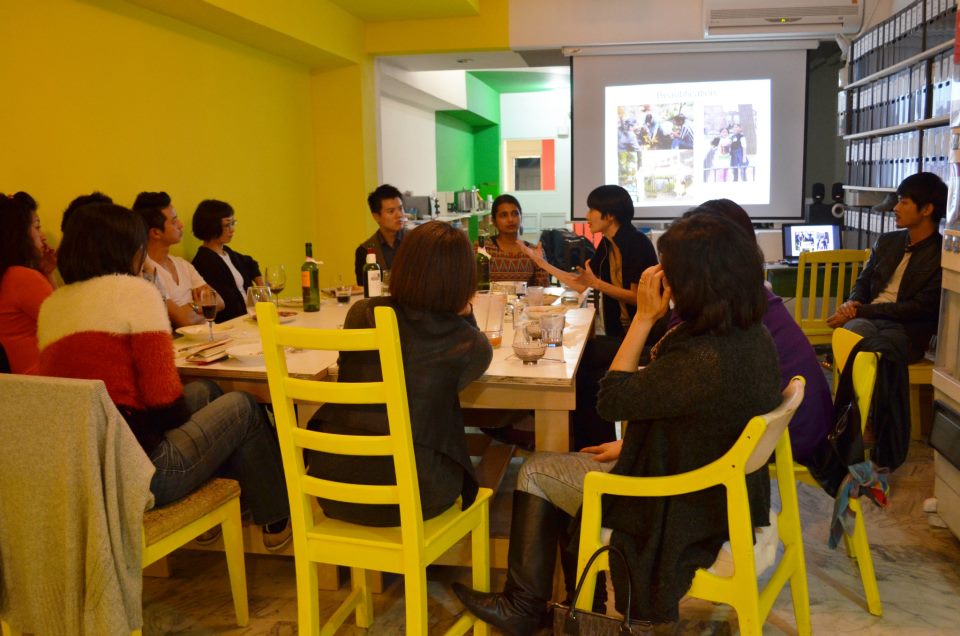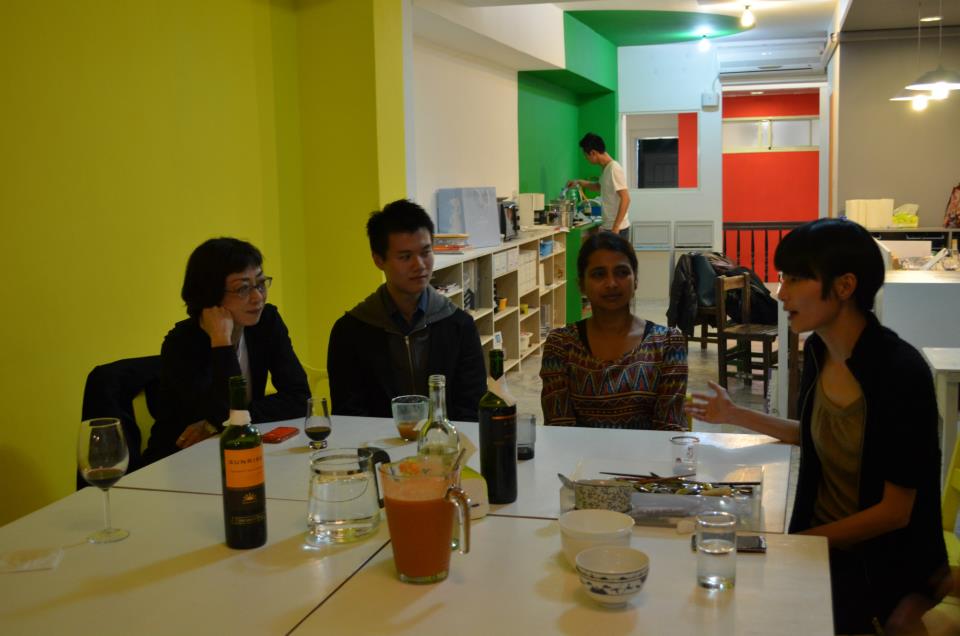2013.01.31:Dinner Gathering – Queens NYC – Hitomi Iwasaki (Director of Exhibitions/Curator)+Prerana Reddy (Director of Public Event)|晚餐聚會-皇后美術館展覽總監&策展人岩崎仁美+公眾事務總監普莉瑞娜‧瑞狄
(For English please scroll down)
台北當代藝術中心(TCAC)邀請台灣美術館界的策展人,包括鳳甲美術館、
這是TCAC在2013重新開幕後的一個新嘗試;
在TCAC的諸多國際訪客中,我們將針對部分藝術工作者,
本次聚會,
另一方面,也希望台灣美術館界的策展人,包括鳳甲美術館、
2013年起,TCAC策畫一系列與國內、外的藝術家、藝評、策展人、機構組織者、文化工作者的小型發表、沙龍、聚會。依主講者設定不同主題,並邀請相關領域的專業工作者一同與會,以三十分鐘的簡短報告作為起始,接續一場深入的交流、分享、討論。這個聚會、發表提供藝術專業工作者一個對話場域,在彼此研究與關注的議題上分享,並作為未來相互連結的起步。
主持人:鄭美雅(獨立策展人)
發表人: Hitomi Iwasaki(皇后美術館主策展人),Prerana Reddy(皇后美術館公共事務總監)
與談者:賴香伶(上海外灘美術館、台北當代館前館長)、賴瑛瑛(台藝大藝術管理與文化政策研究所)、鄭慧華(獨立策展人)、黃舒屏(國美館)、吳達坤(關渡美術館策展人)、林珮鈺(就在藝術空間負責人)、楊俊(藝術家)
特別晚餐:楊俊Jun Yang (藝術家)。
現場翻譯:鄒德平De-Ping Chou
文字報導:許峰瑞Ray Hsu
文字翻譯:林怡君Rebecca Lin
攝影:TCAC
2013.01.31【皇后美術館—案例分享】
皇后區藝術博物館(Queens Museum of Art, QMA)位於美國紐約市皇后區,是美國紐約市的五個行政區之中面積最大、人口第二多的行政區,同時也是族群最多元的一區,除猶太裔白人佔半數外,亞洲裔、拉丁美洲裔、非洲裔人口所佔比例均高於美國外移族群中的平均值。多元族裔的年輕族群、新移民是該地的人口組成特色,而這個社會脈絡則成為QMA在發展各項展覽、公共計畫時所關注的焦點。
皇后區多元文化、語言與族群的歷史背景,及新移民社群在城市治理的發展過程中所產生的複雜文化紋理與社會衝突,因教育水平的斷裂更為突顯。本身具有社區組織經驗、關注青少年、邊緣族群,並為紀錄片導演及研究者的Prerana Reddy在策辦皇后美術館的公共計畫時,積極邀請當地的新移民參與,藉由與藝術家的共同合作及體驗,讓他們對自身所處的社區及社會脈絡開展了深度的瞭解,並發展出展覽、表演、影像放映等等不同形式的藝術成果。此外,為了創造對新移民友善的藝術環境,書籍及展覽計畫等文字也透過各種語言的翻譯進入到不同族群中,這使QMA在經營多元族群文化的努力有著更淺移默化的影響。而就當地藝術生態而言,在同處皇后區、臨近曼哈頓的MOMA-PS1(紐約現代美術館分館)的競爭下,優秀及年輕藝術家的依藝術經濟地理學的群聚效應,較少分佈在QMA所在的法拉盛地區,也因此,QMA必須區隔出一個深根地方的自我定位。在Hitomi Iwasaki及Prerana Reddy的想法中,皇后區缺少專業藝術家的群聚不完全是種困境,反倒促使他們積極邀請藝術家長期進駐,並發展出具有在地脈絡的藝術計畫。這當中不乏實驗性計畫及在地文化建設,而由於每個計畫大多屬於長時間的研究,使得計劃進行的同時,藝術家必須時時衡量與觀眾發展出的關係及短期成果來進行微調與修正,讓不同參數在環境變因下更能趨向研究目標的精準度和精神。
在Hitomi Iwasaki眼裡,長期的社區經營更像是一種活化性的計畫和研究,從策展的角度出發,在藝術與生活的實踐過程以曖昧及重疊性的操作消除了專業藝術的框架邊界,或許這就如她先前策劃「實用藝術展」(utility art)裡頭Tania Bruguera對這類型藝術創作的定義:1 藝術在社會理有新用途;2 挑戰被使用的場域;3 時間明確,現在便可使用;4 真實情境下被安裝使用;5 作者身分變成啟動者,觀眾角色成為使用者;6 對使用者而言是有用的;7 有永續性可適應情況改變;8 把美學變成改變轉換的系統。這展覽過程觸及了民眾對「實用」與「藝術」的觀念框架與詮釋,將藝術推廣到平常不太能接觸到的人與社群,這當中自然存在了不同理解上的碰撞與質疑,但對QMA而言,不論是讚嘆或質疑,這樣的觀看與閱讀經驗本身便是一種當代藝術的經驗,不管是否為當代藝術的專業觀眾,這都是一個當代藝術在不同層次上的洗禮。
當代藝術機構處於文化多元歷史與環境背景,這現象已由全球性的流通成為多數美術館必須面對的課題,而皇后美術館以自身的文化環境所發展出來的都市研究與社區藝術,在這次的分享中也帶給了台灣的地方美術館與藝術機構更多的參照,提供了藝術與社群間溝通的模組經驗。或許能藉此反思,當代藝術該如何從美術館及藝術機構與觀眾建立自身的溝通型態?而展覽本身的公共性該如何定義?對於藝術知識的掌握,我們需要的究竟是美術”館”還是美術”管”?而藝術做為一種知識生產,美術館與藝術機構各自所扮演的角色相當關鍵,在大美術館時代的夕映下,獨立藝術機構在整體生產環境中的分工,或許更需要透過體制結構內外的往返,試著建立自身獨特微型世界系統與定位。藉皇后美術館的案例,這樣的目標對地方藝術機構與場館而言何嘗不是首要之務呢?
In 2013, TCAC plans a series of small-scale publications, salons, parties with domestic and foreign artists, art critics, curators, organizers of institutions, cultural workers., We set different themes according to speakers and invite professionals in related fields to participate in our events, starting from 30-minute brief reports, followed by in-depth exchanges, sharing, and discussion. The gatherings and publications offer arts professionals a dialog field to share researches and issues of concern with each other, and as a starting point of future connections.
Moderator: Meiya Cheng (Independent Curator)
Speaker: Hitomi Iwasaki (Chief Curator of Queens Museum of Art), Prerana Reddy ( Director of Public affairs of Queens Museum of Art)
Panelists: Hsiang-Ling Lai (Former Directors of Rockbund Art Museum and MoCA Taipei), Yingying Lai ( Associate Professor of Graduate School of Art-Culture Policy and Management, National Taiwan University of Arts), Amy Huei-hwa Cheng (Independent Curator), Iris Huang (Curator of National Taiwan Museum of Fine Arts), Wu Dar-kuen (Curator of Kuandu Museum of Fine Arts), Peiyu Lin (Director of Project Fulfill Art Space), Jun Yang (Artist)
2013.01.31 [Queens Museum of Art—Case Sharing]
Queens Museum of Art (Queens Museum of Art, QMA), is located in the borough of Queens, the largest of the five boroughs in New York City, an administrative region with the second largest population, and also the most ethnically diverse urban area. In addition to Jewish accounting for half of population, Asian-American, Latino, and African-American population is higher than the average of immigrant groups in the United States. The young, new immigrants of diverse ethnic backgrounds characterize its population composition and the social context becomes QMA’s focus of concern when developing exhibitions and public plans.
Queens’ historical background of multi cultures, languages and ethnic groups, and the complex cultural texture and social conflicts of the new immigrant community in the process of urban governance, become more obvious because of the gap in educational attainment. Prerana Reddy has the experience of community-based organizations and is concerned about the youth and the margins of society. She is also a documentary filmmaker and researcher. When she was making public plans for the Queens Museum of Art, she actively invited new immigrants to participate. The co-operation and experiences with artists enabled them to develop a deep understanding of their communities and the social contexts. They also got different types of artistic achievements like exhibitions, performances, and video screenings. In addition, in order to create the new immigrant-friendly artistic environment, the texts of books and exhibition projects reach different ethnic groups through translation into a variety of languages. This allows the QMA’s efforts in preserving cultures of diverse ethnic groups to have a more subtle impact. As for the local arts ecology, the MOMA-PS1 (a branch of the Museum of Modern Art in New York), also located in Queens and near Manhattan, competes for outstanding young artists. According to the cluster effect of economic geography in art, fewer artists stay in Flushing, where QMA is. Therefore, QMA must be separated out with a way of self-positioning deeply rooted in local cultures. Hitomi Iwasaki and Prerana Reddy believe that lacking creative clusters developed by professional artists is not an unsolvable predicament, and has actually prompted them to actively invite artists to participate in long-term residency programs, and to develop art projects adapted to the local context. There are many experimental projects and local cultural construction. Because most of them are long-term projects, during the project period, the artists must always measure the relationship developed with the audience and the short-term results to adjust and modify, allowing different parameters in environmental variables to approximate the accuracy of the research objectives and spirit
In Hitomi Iwasaki’s view, the long-term operation of the community is more like an activation plan and research. From a curatorial point of view, the practices of art and life eliminate the boundaries of the framework for professional artists by ambiguous and overlapped operations. Facing this type of artistic creation, perhaps as Tania Bruguera has defined in The Arte Útil (Useful Art), a project she initiated: 1. Art has new function in society; 2 The fields used are challenged; 3 Time is clear, and it can be used now; 4 in real-life situation, it is installed and used; 5 The authors become initiators and the audience plays the role of users; 6 It is useful for users; 7 It has resiliency that can be adapted to changes in circumstances; 8 Aesthetics is transformed into conversion system. The exhibition process touched upon people’s conceptual framework and interpretations of the “useful” and “art,” promoting art to the people and communities we usually do not have access to. There exists, naturally, collision and doubts due to different understandings. But for the QMA, be it praise or doubt, the viewing and reading experience itself is a contemporary art experience. Whether they are professional audience of contemporary art, it is a feast of contemporary art at different levels.
Contemporary art institutions are situated in the historical background and environment of multiculturalism. This phenomenon via global circulation has become an issue most art museums must face. Urban studies and community art developed by the Queens Museum of Art from its own cultural environment also offered, in the sharing, Taiwan’s local art galleries and art institutions references, providing an experience model for communication between art and the community. We might be able to rethink about how contemporary art can build their own communication patterns with the audience from the art galleries and art institutions. How do we define the public nature of the exhibition itself? Concerning art knowledge, we need art museum or art “management”? And art as a kind of knowledge production, the roles of art galleries and institutions are quite critical. In the era of mega-museums, independent art institutions in the division of labor in the overall production environment perhaps need more journeys through the institutional structure, trying to establish their own unique micro-world systems and determine their positions. By the case of the Queens Museum of Art, isn’t this goal a primary task for the local arts agencies and venues?
活動紀錄
更多照片:https://www.facebook.com/media/set/?set=a.10151602859099878.1073741827.361110184877&type=3



